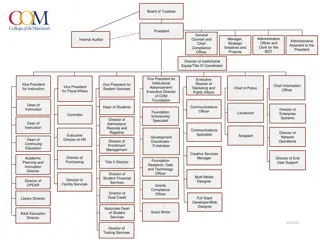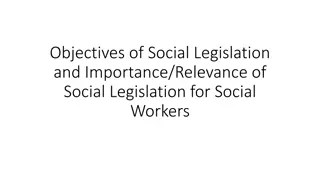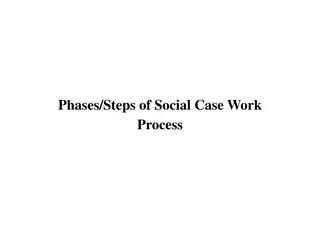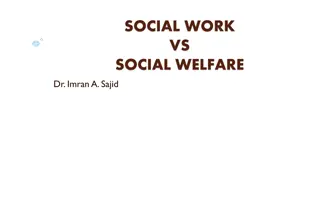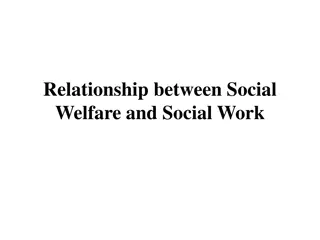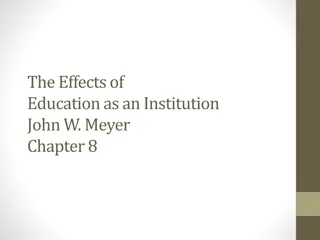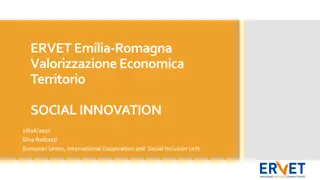Understanding Family as a Social Institution
Family, as a social institution, plays a crucial role in societies worldwide by uniting individuals in cooperative groups to care for one another and any children involved. It serves as the primary unit responsible for reproduction and nurturing within society. Various types of families exist, including nuclear and extended families, each with unique dynamics and structures. Marriage, a legal relationship involving economic cooperation and childbearing, is a fundamental aspect of family life. Different forms of marriage, such as monogamy, polygamy, polygyny, and polyandry, reflect diverse cultural norms regarding spousal relationships.
Download Presentation

Please find below an Image/Link to download the presentation.
The content on the website is provided AS IS for your information and personal use only. It may not be sold, licensed, or shared on other websites without obtaining consent from the author. Download presentation by click this link. If you encounter any issues during the download, it is possible that the publisher has removed the file from their server.
E N D
Presentation Transcript
Family as Social Institution IMRAN AHMAD SAJID imranahmad131@upesh.edu.pk
FAMILY John J. Macionis Family is a social institution found in all societies that unites people in cooperative groups to care for one another, including any children Giddens A family is a group of persons directly linked by kin connections, the adult members of which assume responsibility for caring for children.
Richard T. Shaefer a set of people who are related by blood, marriage, or adoption, who share the primary responsibility for reproduction and caring for members of society. Eliot and Merril Family is the biological social unit composed of husband, wife, and children.
Types of Family 1. Nuclear Family A family composed of one or two parents and their children. Married couple living together with their unmarried children. 2. Extended Family A family in which relatives such as grandparents, aunts, or uncles live in the same home as parents and their children. conjugal family consanguine family
MARRIAGE A legal relationship, usually involving economic cooperation, sexual activity, and childbearing (Macionis, 2012). a legally recognized relationship, established by a civil or religious ceremony, between two people who intend to live together as sexual and domestic partners(Encarta, 2008)
Forms of Marriage: How many Spouse? 1. Monogamy A form of marriage in which one woman and one mane are married only to each other. 2. Serial Monogamy A person may have several spouses in his or her life, but only one spouse at a time.
3. Polygamy A form of marriage in which an individual have several husbands or wives simultaneously. 4. Polygyny A form of marriage in which a husband may have several wives at the same time. 5. Polyandry A form of marriage in which a woman may have several husbands at the same time. Islamic permits 4 wives Practiced in Tibet
6. Endogamy A form of marriage in which the partners belong to the same kinship or lineage. 7. Exogamy A form of marriage in which members of the same lineage may not marry. In rural areas of India, people are expected to marry someone of the same caste (endogamy) but from a different village (exogamy)
Kinship Patterns: Kinship Kinship is a social bond based on common ancestry, marriage, or adoption. It is the state of being related to others.
To Whom are we Related? Patterns of Descent 1. Patrilineal Kinship system where descent favours father s relatives in terms of property, inheritance, and emotional ties. 2. Matrilineal Kinship system in which descent favours the mother s relatives. 3. Bilateral Descent Kinship system in which both sides of a person s family are regarded as equally important. Descent refers to the system by which members of a society trace kinship over generations.
Who Rules? Authority Patterns in Family 1. Patriarchy A family authority pattern in which male is expected to dominate in family decision making. 2. Matriarchy A family pattern in which women dominate in family decision making. 3. Egalitarian Family Family authority pattern in which spouses are regarded as equals.
Family Residential Patterns 1. Patrilocal A residential pattern in which a married couple lives with or near the husband s family. 2. Matrilocal A residential pattern in which a married couple lives with or near the wife s family. 3. Neolocal A residential pattern in which a married couple lives apart from both sets of parents.
FUNCTIONS OF FAMILY 1. Reproduction 2. Protection 3. Socialization 4. Regulation of Sexual behaviour / Mate Selection 5. Affection and companionship 6. Provision of social status 7. Economic function 8. Recreation




